oil pressure Peugeot Expert VU 2016 Owner's Manual
[x] Cancel search | Manufacturer: PEUGEOT, Model Year: 2016, Model line: Expert VU, Model: Peugeot Expert VU 2016Pages: 599, PDF Size: 13.14 MB
Page 15 of 599
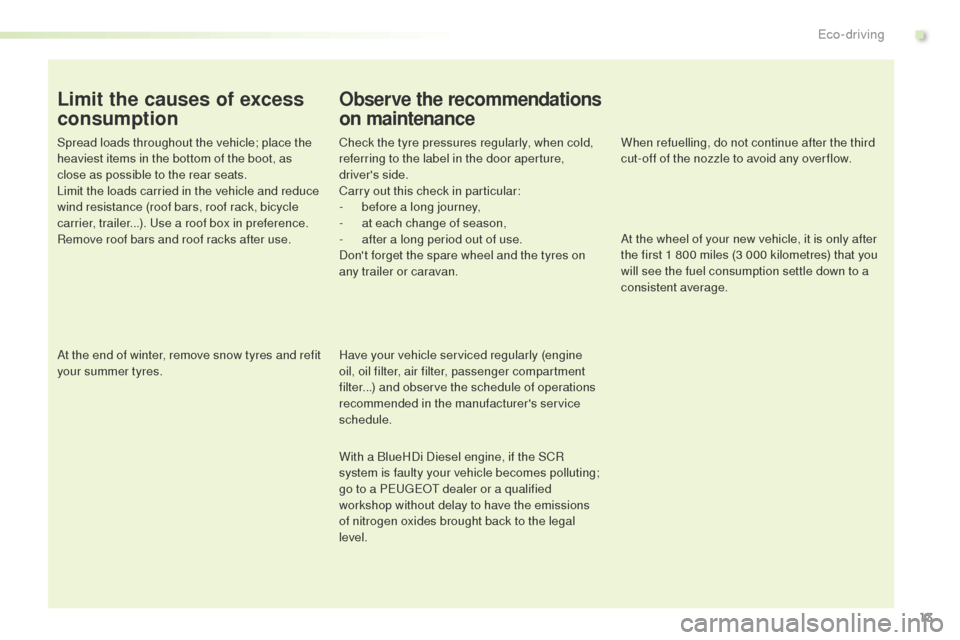
13
Expert_en_Chap00c_eco-conduite_ed01-2016
Limit the causes of excess
consumption
Spread loads throughout the vehicle; place the
heaviest items in the bottom of the boot, as
close as possible to the rear seats.
Limit the loads carried in the vehicle and reduce
wind resistance (roof bars, roof rack, bicycle
carrier, trailer...). u
s
e a roof box in preference.
Remove roof bars and roof racks after use.
At the end of winter, remove snow tyres and refit
your summer tyres.
Observe the recommendations
on maintenance
Check the tyre pressures regularly, when cold,
referring to the label in the door aperture,
driver's side.
Carry out this check in particular:
-
b
efore a long journey,
-
a
t each change of season,
-
a
fter a long period out of use.
Don't forget the spare wheel and the tyres on
any trailer or caravan.
Have your vehicle serviced regularly (engine
oil, oil filter, air filter, passenger compartment
filter...) and observe the schedule of operations
recommended in the manufacturer's service
schedule.
With a BlueHDi Diesel engine, if the SCR
system is faulty your vehicle becomes polluting;
go to a PE
u
g
Eo
t dealer or a qualified
workshop without delay to have the emissions
of nitrogen oxides brought back to the legal
level. When refuelling, do not continue after the third
cut-off of the nozzle to avoid any over flow.
At the wheel of your new vehicle, it is only after
the first 1 800 miles (3 000 kilometres) that you
will see the fuel consumption settle down to a
consistent average.
.
Eco-driving
Page 21 of 599

19
Expert_en_Chap01_instruments-de-bord_ed01-2016
Warning / indicator lampStateCause Action / Observations
Seat belt(s)
not fastened /
unfastened fixed
or flashing
accompanied by an
audible signal. A seat belt has not been fastened or
has been unfastened.
Pull the strap then insert the tongue in the buckle.
* Depending on the country of sale. Battery charge
*fixed.
th
e battery charging circuit has a
fault (dirty or loose terminals, slack or
cut alternator belt, ...).
th
e warning lamp should go off when the engine is
started.
If it does not go off, contact a PE
u
g
Eo
t dealer or a
qualified workshop.
Engine oil
pressure fixed.
th
ere is a fault with the engine
lubrication system. You must stop as soon it is safe to do so.
Park, switch off the ignition and contact a PE
u
g
Eo
t
dealer or a qualified workshop.
or Maximum
coolant
temperature
fixed with the needle
in the red zone.
th
e temperature of the cooling
system is too high. Stop as soon as it is safe to do so.
Wait until the engine has cooled down before topping-
up the level, if necessary.
If the problem persists, contact a PE
u
g
Eo
t dealer or
a qualified workshop.
fixed (only with the
LCD instrument
panel).
1
Instruments
Page 30 of 599

28
Warning / indicator lampStateCause Action / Observations
Rear foglamps fixed.
th
e rear foglamps are on.
tu
rn the ring on the stalk rear ward to switch off the
rear foglamps.
Service
on temporarily. A minor fault has occurred for which
there is no specific warning lamp. Identify the fault by means of the associated message,
for example:
-
l
ow engine oil level,
-
l
ow screenwash/headlamp wash fluid level,
-
d
ischarged remote control battery,
-
l
ow tyre pressures,
-
s
aturation of the particle filter (FAP) on Diesel
vehicles.
-
...
For more information on Checks and in particular the
particle filter, refer to the corresponding section.
For any other faults, contact a PE
u
g
Eo
t dealer or a
qualified workshop.
fixed. A major fault has occurred for which
there is no specific warning lamp. Identify the fault by reading the message and contact
a PE
u
g
Eo
t dealer or a qualified workshop.
+ fixed, associated with
flashing and then fixed
display of the service
spanner.
the
servicing interval has been
exceeded.
on
ly on BlueHDi Diesel versions.
Your vehicle must be serviced as soon as possible.
Instruments
Page 33 of 599
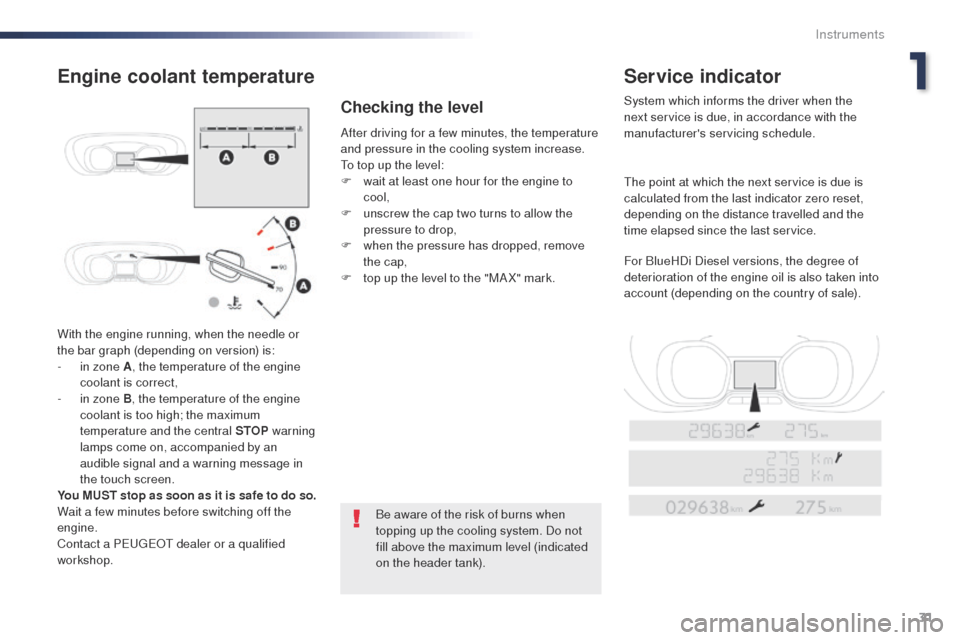
31
Expert_en_Chap01_instruments-de-bord_ed01-2016
With the engine running, when the needle or
the bar graph (depending on version) is:
-
i
n zone A , the temperature of the engine
coolant is correct,
-
i
n zone B, the temperature of the engine
coolant is too high; the maximum
temperature and the central STOP warning
lamps come on, accompanied by an
audible signal and a warning message in
the touch screen.
You MUST stop as soon as it is safe to do so.
Wait a few minutes before switching off the
engine.
Contact a PE
u
g
Eo
t dealer or a qualified
workshop. After driving for a few minutes, the temperature
and pressure in the cooling system increase.
to t
op up the level:
F
w
ait at least one hour for the engine to
cool,
F
u
nscrew the cap two turns to allow the
pressure to drop,
F
w
hen the pressure has dropped, remove
the cap,
F
t
op up the level to the "MA X" mark.
Be aware of the risk of burns when
topping up the cooling system. Do not
fill above the maximum level (indicated
on the header tank).
Engine coolant temperature Service indicator
System which informs the driver when the
next service is due, in accordance with the
manufacturer's servicing schedule.
th
e point at which the next service is due is
calculated from the last indicator zero reset,
depending on the distance travelled and the
time elapsed since the last service.
For BlueHDi Diesel versions, the degree of
deterioration of the engine oil is also taken into
account (depending on the country of sale).Checking the level
1
Instruments
Page 279 of 599
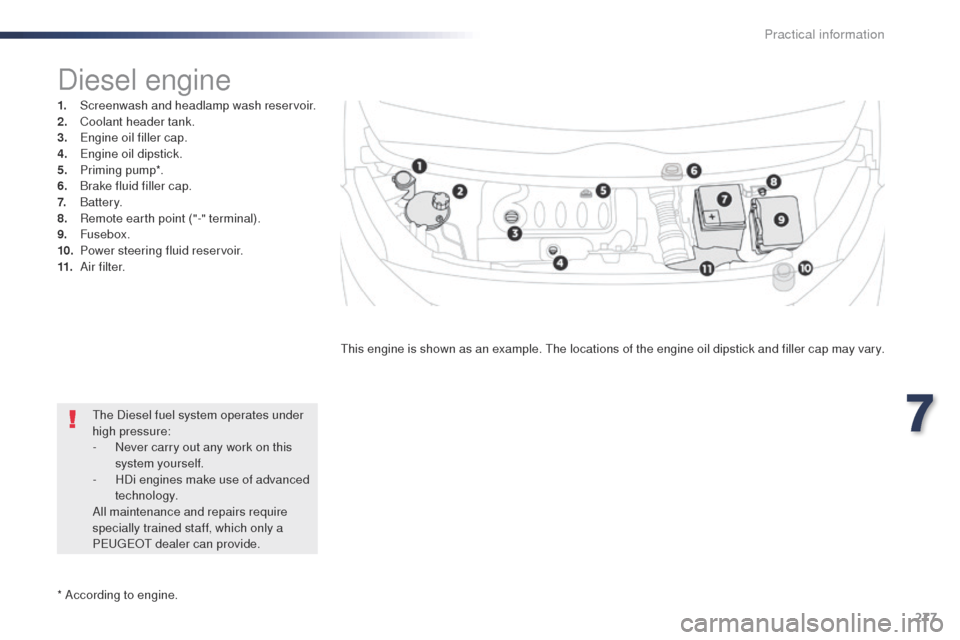
277
Expert_en_Chap07_info-pratiques_ed01-2016
* According to engine.
Diesel engine
1. Screenwash and headlamp wash reservoir.
2. Coolant header tank.
3.
E
ngine oil filler cap.
4.
E
ngine oil dipstick.
5.
P
riming pump*.
6.
B
rake fluid filler cap.
7.
Battery.
8.
R
emote earth point ("-" terminal).
9.
Fusebox.
10.
P
ower steering fluid reservoir.
11.
A
i r f i l t e r.
th
is engine is shown as an example. t
h
e locations of the engine oil dipstick and filler cap may vary.
th
e Diesel fuel system operates under
high pressure:
-
N
ever carry out any work on this
system yourself.
-
H
Di engines make use of advanced
technology.
All maintenance and repairs require
specially trained staff, which only a
PE
ugEo
t
d
ealer can provide.
7
Practical information
Page 281 of 599
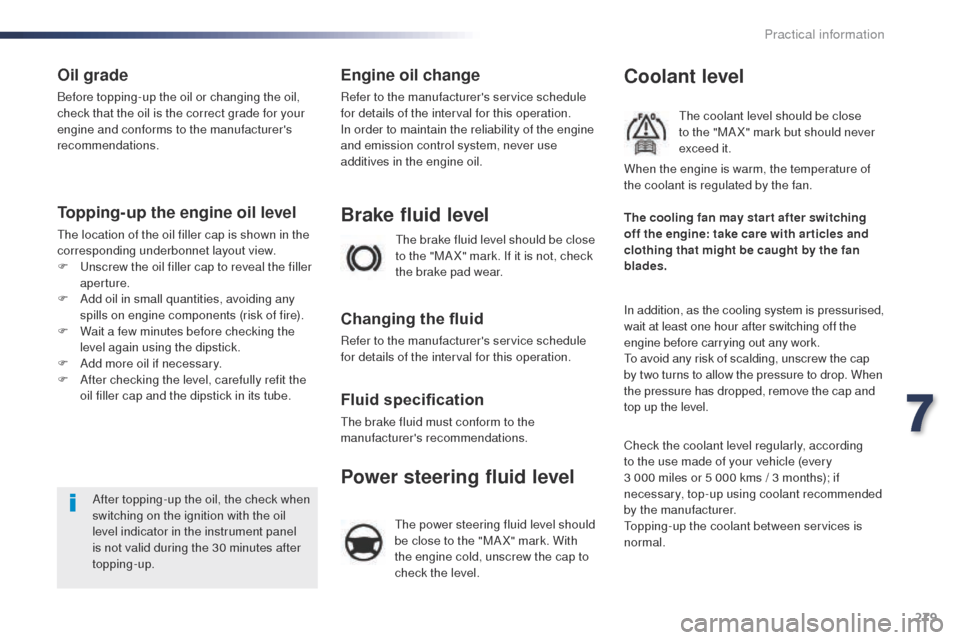
279
Expert_en_Chap07_info-pratiques_ed01-2016
Oil grade
Before topping-up the oil or changing the oil,
check that the oil is the correct grade for your
engine and conforms to the manufacturer's
recommendations.
Topping-up the engine oil level
the location of the oil filler cap is shown in the
corresponding underbonnet layout view.
F u
n
screw the oil filler cap to reveal the filler
aperture.
F
A
dd oil in small quantities, avoiding any
spills on engine components (risk of fire).
F
W
ait a few minutes before checking the
level again using the dipstick.
F
A
dd more oil if necessary.
F
A
fter checking the level, carefully refit the
oil filler cap and the dipstick in its tube.
After topping-up the oil, the check when
switching on the ignition with the oil
level indicator in the instrument panel
is not valid during the 30 minutes after
topping-up.
Engine oil change
Refer to the manufacturer's service schedule
for details of the interval for this operation.
In order to maintain the reliability of the engine
and emission control system, never use
additives in the engine oil.
th
e brake fluid level should be close
to the "MA X" mark. If it is not, check
the brake pad wear.
Brake fluid level
Changing the fluid
Refer to the manufacturer's service schedule
for details of the interval for this operation.
Fluid specification
the brake fluid must conform to the
manufacturer's recommendations.
Coolant level
the coolant level should be close
to the "MA X" mark but should never
exceed it.
In addition, as the cooling system is pressurised,
wait at least one hour after switching off the
engine before carrying out any work.
to a
void any risk of scalding, unscrew the cap
by two turns to allow the pressure to drop. When
the pressure has dropped, remove the cap and
top up the level. The cooling fan may star t after switching
off the engine: take care with ar ticles and
clothing that might be caught by the fan
blades. When the engine is warm, the temperature of
the coolant is regulated by the fan.
Check the coolant level regularly, according
to the use made of your vehicle (every
3 000
miles or 5 000 kms / 3 months); if
necessary, top-up using coolant recommended
by the manufacturer.
to
pping-up the coolant between services is
normal.
Power steering fluid level
the power steering fluid level should
be close to the "MA X" mark. With
the engine cold, unscrew the cap to
check the level.
7
Practical information
Page 295 of 599

293
Expert_en_Chap08_En-cas-de-panne_ed01-2016
If after around 5 to 7 minutes the
pressure is not attained, this indicates
that the tyre is not repairable; contact
a PE
u
g
Eo
t dealer or a qualified
workshop for assistance.
F
S
witch on the compressor by moving
the switch B to position "I" until the tyre
pressure reaches 2.0 bars.
t
h
e sealant is injected into the tyre under
pressure; do not disconnect the pipe from
the valve during this operation (risk of
splashing). F
R
emove the kit and screw the cap back on
the white pipe.
t
a
ke care to avoid staining your vehicle
with traces of fluid. Keep the kit to hand.
2. Inflation
F turn the selector A to the "Air" position.
F
u
n
coil the black pipe H fully.
F
C
onnect the black pipe to the valve of the
wheel.
F
D
rive immediately for approximately
three miles (five kilometres), at reduced
speed (between 15 and 35 mph (20 and
60
km/h)), to plug the puncture.
F
S
top to check the repair and the tyre
pressure using the kit.
8
In the event of a breakdown
Page 297 of 599
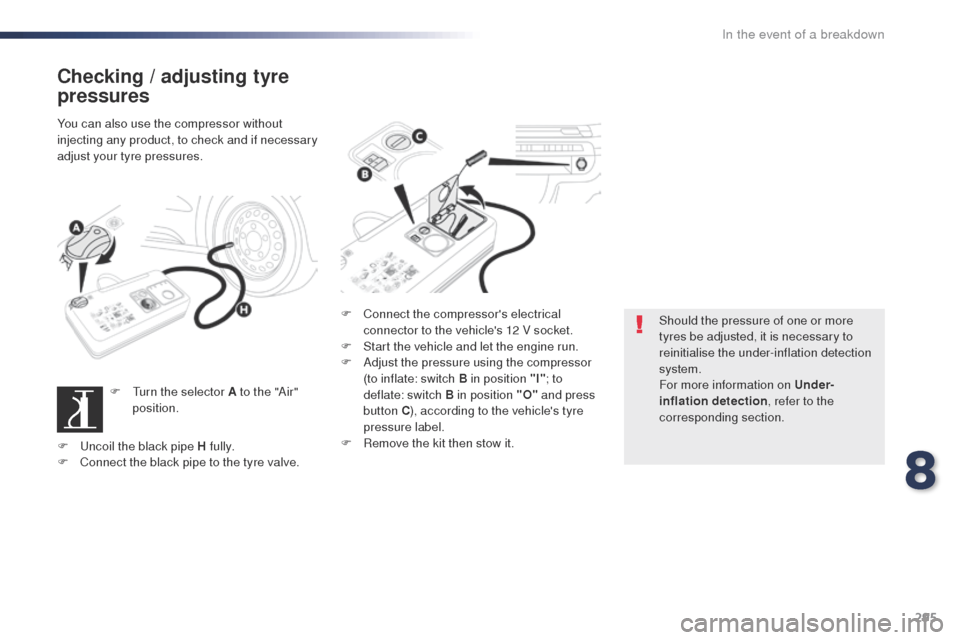
295
Expert_en_Chap08_En-cas-de-panne_ed01-2016
Checking / adjusting tyre
pressures
You can also use the compressor without
injecting any product, to check and if necessary
adjust your tyre pressures.F
t
u
rn the selector A to the "Air"
position. F
C
onnect the compressor's electrical
connector to the vehicle's 12 V socket.
F
S
tart the vehicle and let the engine run.
F
A
djust the pressure using the compressor
(to inflate: switch B in position "I" ; to
deflate: switch B in position "O" and press
button C ), according to the vehicle's tyre
pressure label.
F
R
emove the kit then stow it.Should the pressure of one or more
tyres be adjusted, it is necessary to
reinitialise the under-inflation detection
system.
For more information on Under-
inflation detection
, refer to the
corresponding section.
F
u
n
coil the black pipe H fully.
F
C
onnect the black pipe to the tyre valve.
8
In the event of a breakdown
Page 509 of 599

507
Expert_en_Chap11_index-alpha_ed01-2016
D
E
DAB (Digital Audio Broadcasting) - Digital radio ................... 396, 397, 452, 453, 490, 491
Date (setting)
...............................
....46, 420, 476
Daytime running lamps
.........146, 149, 3 0 4 - 3 0 6
Deactivating the passenger airbag
.......171, 17 7
Deactivation of DSC (ESC)
...........................163
Deadlocking
........................................ 51, 58, 65
Defrosting
.............................................. 132, 14 4
Demisting
...............................
.......................132
Demisting, rear
...................................... 13
3, 13 4
Demisting, rear screen
.........................13 3, 13 4
Diagnostic system, engine
..............................21
Dial
............................................................ 15, 16
Dials and gauges
............................................ 14
Dimensions
........................................... 328-330
Dipstick
................
.................................... 34, 278
Direction indicators
....148, 304, 307, 308, 310, 313, 315
Display, head-up
........................................... 222
Display screen, instrument panel
......14 -16, 2 0 8
Door pockets
................................................. 12
0
Doors
............................................................... 74
Doors, rear
...................................................... 91
Doors, side-hinged
........64, 65, 91-93, 310, 311 EBA
...............................................................161
EBFD
.............................................................161
Eco-driving (advice)
........................................12
Economy mode
.............................................270
Electric windows
.............................................98
Electronic brake force distribution (EBFD)
........................................................161
Emergency call
..................................... 16
0, 338
Emergency warning lamps
................... 1
60, 287
Emissions control system, SCR
.....................27
Energy economy mode
.................................270
Engine compartment
....................................277
Engine, Diesel
............21, 267, 277, 327, 333, 335, 336
Environment
...............................
.12, 54, 70, 139
ESC/ASR
...............................
........................161
ESC (electronic stability control)
....................25
ESC system
.....................................................25
Changing a fuse
............................
316, 317, 320
Changing a wheel
.........................................
296
Changing a wiper blade
........................
15 9 , 2 74
Changing the remote control battery
........
54, 70
Checking the engine oil level
..........................
34
Checking the levels
...............................
278-280
Checking tyre pressures (using the kit)
..............................
................
290
Checks
...............
...........................
277, 281, 282
Checks, routine
.....................................
281, 282
Child lock
...............................
................
19 4, 195
Child lock, electric
...............................
..........
19 4
Child lock on rear windows
...........................
195
Children
...............................
..
182, 187, 188, 190
Children (safety) ...............................
.............
19 4
Child seats
..............................
..... 16 9, 174 -176 ,
180 -182, 18 4, 193
Child seats, conventional
.............. 180 -182, 18 4
Child seats, IS
oF
IX
...................... 1
87, 188, 190
Closing the boot
.............................................. 94
Closing the doors
... 5
9, 64, 74, 75, 77, 82, 91, 93
Collision risk alert
................... 2
3, 243-245, 247
Compressor, tyre inflation
............................ 290
Connection, Bluetooth
.... 380, 406 - 408, 436, 462- 464, 498
Connection, MirrorLink
........ 382, 384, 438, 440
Connection, Wi-Fi network
................... 3 81, 4 37
Connectivity
.......................................... 378, 434
Control, emergency boot release
................... 94
Control, emergency door
..........................53, 68
Control, heated seats
............................ 103, 105
Control stalk, lighting
.............................. 3
0, 146
Control stalk, wipers
............................. 15 6, 157
Courtesy lamp
............................................... 312
Courtesy lamp, front
.............. 141, 142, 312, 315
Courtesy lamp, rear
............... 141, 142, 312, 315
Courtesy lamps
...................... 141, 142, 312, 315
Cover, load space
......................................... 12
3
Crew cab, fixed
............................................. 117Cruise control
................
2
24, 227, 232, 233, 237
Cruise control, adaptive
........................ 2
2 7, 2 3 6
Cruise control by speed limit recognition
.....
2
27
Driver's door open warning
.............................
75
Driver’s fatigue warning
........................ 25
0, 251
Driving abroad ............................................... 148
Driving economically ....................................... 12
Driving time warning
.............................
250, 251
DSC
............................................................... 16
1
Dynamic stability control (DSC)
....................................
25, 161, 163, 16 4
.
Alphabetical index
Page 512 of 599

510
Expert_en_Chap11_index-alpha_ed01-2016
Pads, brake ................................................... 282
Paint colour code .......................................... 337
Parking brake
.................................. 18, 205, 282
Parking sensors, audible and visual
.............256
Parking sensors, front
...................................256
Parking sensors, rear ............................255, 256
PE
u
g
Eo
t Connect Assistance ...................338
PE
u
g
Eo
t Connect Nav
...............................3
41
P
Eu
g
Eot C
onnect Packs
...........................338
PE
u
g
Eo
t Connect Radio ...........................429
P
Eu
g
Eot C
onnect S
oS ............................. 33
8
Plates, identification ...................................... 337
Platform cab
.......................................... 3
15, 332
Player, Apple
® .............................. 3 99, 455, 495
Player, MP3 CD ............................................. 494
Player,
u
S
B
.................................. 398, 454, 492
Port,
u
S
B
............................. 1
22, 398, 454, 492
Pressures, tyres
................... 290, 295, 302, 337 Pre-tensioning seat belts
..............................
169
Priming pump
................................................
327
Priming the fuel system ................................
327
Profiles
..................................................
418 , 474
Protecting children
.................
171, 174 -176 , 18 2 ,
187, 188, 190, 193
Puncture
........................................................
290
Radio
...................
394, 398, 450, 454, 488, 489
Radio, digital (Digital Audio Broadcasting - DAB)
..........
396, 397, 452, 453
Radio Media
........
388, 390, 392, 444, 446, 448
Range
..............................................................
42
Range, AdBlue
................................................
35
RDS
.......................................................
3 9 5 , 4 51
Rear screen, demisting
.........................
13 3, 13 4
Recharging the battery
................................. 32
3
Recirculation, air
...................
125, 126, 128, 131
Reduction of electrical load
..........................
270
Regeneration of the particle filter
.................
2
81
Reinitialisation of the under-inflation detection system .........................................
263
Reinitialising the remote control
............... 5
4, 70
Reminder, key in ignition ...............................
201
Reminder, lighting on ....................................
148
Remote control
...... 4
7-50, 52, 55 -59, 67, 68, 71, 74, 75
Removing a wheel
........................................299
Removing the mat
.........................................11 9Safety, children
......................
17
1, 174 -176 , 18 2 ,
187, 188, 190, 193
Saturation of the particle filter (Diesel)
.........
2
81
Screen, instrument panel ..........................
4 0 , 41
Screen menu map .......
352, 354, 356, 360, 362,
370, 372, 374, 378, 384, 386, 388, 390, 392, 400, 402, 404, 412, 414, 416, 434, 440, 442,
444, 446, 448, 456, 458, 460, 468, 470, 472
Screen, multifunction (with audio system)
....487
P
R
S
Replacing bulbs .....3 03, 3 0 4, 310, 311, 313 - 315
Replacing fuses .............................. ......316, 317
Replacing the air filter
...................................281
Replacing the oil filter
................................... 2
81
Replacing the passenger compartment filter
...................................... 281
Reservoir, headlamp wash
...........................280
Reservoir, screenwash
................................. 28
0
Reset journey
.................................................. 41
Resetting the service indicator
.......................33
Resetting the trip recorder
..............................38
Rev counter
................................................ 14 -16
Reversing camera
......................................... 259
Reversing camera (on interior mirror)
..........258
Reversing lamp
............................. 31
0, 313, 315
Roof bars
............................................... 2
72, 273
Roof rack
............................................... 2
72, 273
Running out of fuel (Diesel)
..........................3
27oi
l change
..................................................... 278oi
l consumption
............................................ 278
oi
l, engine
...............................
...................... 278
on
-board tools
...................................... 287, 289
op
ening the bonnet
...................................... 2
76
op
ening the boot
..............................
.. 47, 59, 94
op
ening the doors
....... 4
7, 59, 74, 78 - 81, 83, 93
op
ening to 90/180/235°
.................................. 92
op
ening to 180°
.............................................. 91
O
Alphabetical index